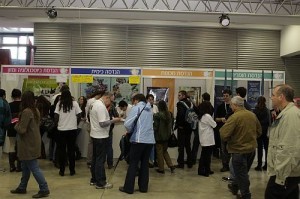In a Lecture at the Technion “Open Day”: Travel Habits Studied Using Cell Phones will Assist the Ministry of Transport in Creating Future Transportation Models; “In the Tel Aviv Metropolis, 2,400 Man-years are Wasted on the Road in One Month”; About 3,000 Candidates Came to Get Acquainted with the Technion
 New data about the traveling habits of Israeli residents, collected using cell phones, were revealed in a lecture given by the Head of the Transportation Research Institute at the Technion, Prof. Shlomo Bekhor of the Faculty of Civil and Environmental Engineering, in an “open day” at the Technion. Prof. Bekhor, who is considered to be a pioneer in this research field, presented two projects he has participated in, that were carried out for the Ministry of Transport.
New data about the traveling habits of Israeli residents, collected using cell phones, were revealed in a lecture given by the Head of the Transportation Research Institute at the Technion, Prof. Shlomo Bekhor of the Faculty of Civil and Environmental Engineering, in an “open day” at the Technion. Prof. Bekhor, who is considered to be a pioneer in this research field, presented two projects he has participated in, that were carried out for the Ministry of Transport.
The first project attempts to provide a temporal and spatial description of traffic congestion in the road system, namely the times and locations in which heavy traffic can be expected, and the amount of time that is lost due to traffic congestion on the roads. “In the Tel Aviv metropolis, 2,400 man-years are wasted on the road in one month, and that’s a huge number”, explains Prof. Bekhor. “If we can predict traffic volumes and the length of queues, we will have a significantly better ability to plan means of transportation, based on a statistical model, and in the future we will be able to explain travels and assist in urban planning”. The Ministry of Transport uses a travel database it has set up, the data for which was obtained using cell phones, to plan roads and additional means of transportation. The products of this method have allowed the creation of models for shortening travel also for 2030.
A second project identifies the point of origin and the destination of travels based on the recorded cell phone location data. Prof. Bekhor: “the information received for each sampled cell phone includes an identification number that is different from its line number, and its location at any time during its tracking in terms of the coordinates of the antenna providing coverage, which is usually the antenna closest to it. The cell phone location is recorded at a frequency of once every two hours in the absence of any movement or call, and whenever movement is discerned through change in the antenna providing coverage. A person can be identified as being at his home, when no movement is recorded for the phone during the night. No data can be obtained if the phone is turned off”. It should be noted, that the research focused on a work week, namely Sunday to Thursday, and the data were collected by private companies. Research conducted in the Technion by Ms. Iliel Blum, under Prof. Bekhor’s guidance, succeeds in identifying long-distance as well as short-distance travels, and to overcome the problems of “leaps” between adjacent antennas.
A method employed until recently, which used surveys, provided inaccurate results. Thus, for example, cell phone data showed that 28,000 people make their way from Tel Aviv to Jerusalem daily. The results of a survey conducted pointed to about half this true and accurate quantity. The reliance on similar surveys done in the past has had an adverse impact on current transportation planning.
Nonetheless, there are limitations that derive from the passive nature of the collection of such data, since the information collected anyway by the communications service providers is not designed for transportation uses, but rather for the orderly operation of the cell phone technology. One of the questions raised is the ethical question, which has to do with invasion of privacy. The Ministry of Transport received special permission to investigate travel habits using cell phones despite the fact that in many Western countries use of this method is avoided. Additional disadvantages are: lack of information about the travel goals, and non-familiarity with the characteristics of the traveler (whose data are not known to the cell phone company either, since it has only the details of the person billed, who could also be the user’s employer, parent, etc.). In addition, the means of transportation is also unclear.
Above: The stand of the Faculty of Materials Engineering, adorned with ties featuring the quasi–periodic crystals pattern, drew substantial attention following faculty member Prof. Dan Shechtman’s win of the 2011 Nobel Prize in Chemistry. Photo: Yoav Becher, Technion Spokesman


